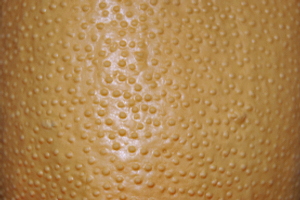In an article this week in the New York Times, brainpower was correlated with the complexity of nerve synapses. Leading researcher Dr. Grant, who has studied the interconnectedness of neurons, likened this connection to technology; "From the evolutionary perspective, the big brains of vertebrates not only have more synapses and neurons, but each of these synapses is more powerful - vertebrates have big Internets with big computers and invertebrates have small Internets with small computers." The brain has been made analogous to a computer before in order to study evolutionary adaptation. However, the brain was not the organ being studied, rather it was human skin.
Have you ever wondered why we have hair only on the tops of our heads and the rest of our skin is relatively bare? Why does our skin come in so many pigmentations? And why does our skin sweat? Dr. Nina Jablonski kept asking why and attributes these adaptations to the need to keep our brain cool. I first heard Dr. Nina Jablonski speak about her most recent book, Skin: A Natural History, in early 2007. I was absolutely enthralled and two hours raced by as she articulated her fascination with skin. Dr. Jablonski divulged into why our skin appears and acts the way it does from an evolutionary standpoint. Her findings showed that about two million years ago our ancestors were running long distances in Africa under the heat of the equatorial sun. To keep their brains cool, sweat glands became more prominent. This in turn let brain size expand and evolve. In the fossil record, it shows after this increase in brain size, Homo sapiens left Africa to migrate into Mainland China.
 Skin:A Natural History
Skin:A Natural History
So skin was an evolutionary adaptation to keep our large brains cool and working effectively. Skin color, Dr. Jablonski surmised, was what regulated our body's reaction to the sun and its rays. Dark skin evolved to protect the body of those of our ancestors close to the equator. Those ancestors further away evolved light skin in order to take in Vitamin D in less sunny climates. After her talk about Rosacea, which is a condition of constant blushing found in Eastern European nationalities, I asked Dr. Jablonski why. She told me this might have been attributed to ancestors of light skin being overly bundled and getting over-heated. It might have been an adaptation to release heat and cool the brain from the only exposed skin.
In her lecture, Dr. Jablonski did not stop with touching upon evolutionary adaptations, she also delved into how we associate and identify through our skin. We decorate our skin, clothe it, paint it, tattoo it, scar and pierce it. She elucidated skin as an intimate connection with the world as well as our presentation of individuality. Skin: A Natural History and Dr. Nina Jablonski have gained national recognition. She was even invited as a guest on the Colbert Report to talk about her findings. It is rumored that she is following up Skin with more in-depth research. Until then, this is an outstanding look at a very under-appreciated organ, one that might have made the complex nuances of our brain and its synapses possible.
